Learning and Teaching
Inquiry Based Learning

Learning and Teaching
Inquiry Based Learning
This week, at our staff meeting, the staff read Chapter 2 of Kath Murdoch’s Power of Inquiry: Creating the Space. We began the chapter by looking at the big questions: How can we design learning environments for inquiry? We were able to have rich discussions around the concepts written about in this chapter.
Kath writes: “Establishing a safe, trusting emotional climate opens the gate to rigorous intellectual activity, and this is where the great joy of inquiry learning can be most keenly felt.” The intellectual environment is a critical element in creating a ‘habitat’ for inquiry. The intellectual tone is set by the teacher and, more specifically, through the language the teacher uses and the opportunities for quality classroom discourse provided. What we say, how we say it, when we say it and what we choose NOT to say is at the core of the teacher’s tool kit.”
Within this chapter we were challenged with many questions that forced us to look at how we use our environment as the third teacher, (parents and teachers being the first and second) and what kind of experiences we want for our students so that their curiosity is nurtured.
Some questions that you might like to ask yourself about your schooling or yourself as a learner:

